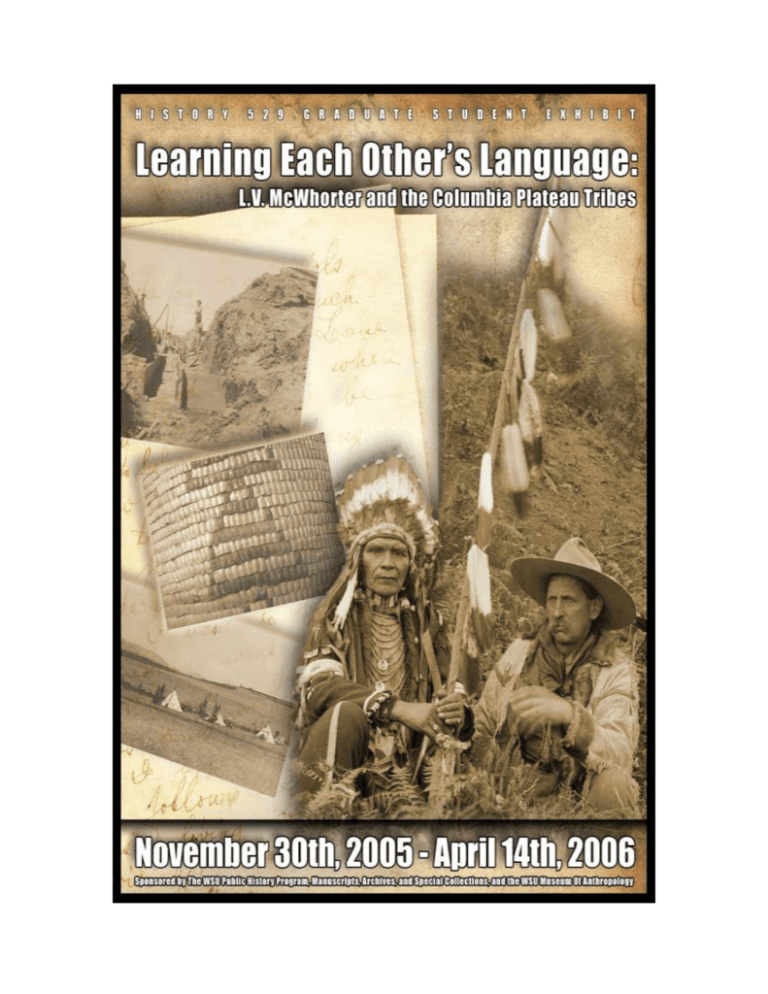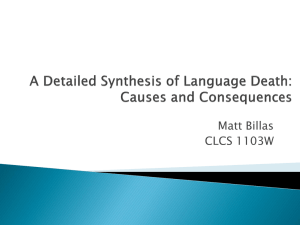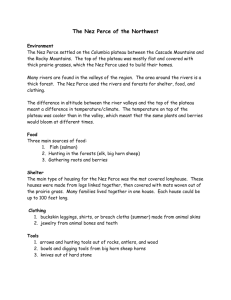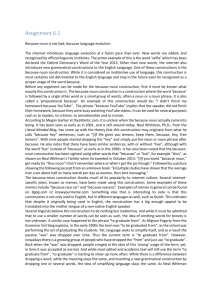Enterprise: Jointly beneficial economic activities
advertisement

BIOGRAPHY Lucullus Virgil McWhorter was born on the upper waters of the Monongahela River in Harrison County Virginia (later West Virginia) on January 29, 1860. McWhorter's critical study of 19th century American history and his romantic appreciation of nature combined to form his view that the American Indian was the true "aboriginal American." In the course of his life he became an ardent ally and supporter of various Indian tribes, strongly sympathizing with their resentment over the often bad treatment meted out to them by early white settlers and later by the military, "Indian grafters," and the Federal bureaucracy. Acting on the impulse for adventure and to see Indians first-hand, McWhorter set out on a lark in 1881 to trek through the coastal regions of Mississippi, Louisiana, and Texas. Eventually, he saw his first Indians in Oklahoma, where he nearly encountered Chief Joseph and the exiled Nez Perces. After selling off what he could of disposable property, he and his family left Ohio, moving to the Yakima River Valley in Washington State in 1903. It was there that his involvement with Indian history and culture matured and continued throughout the remainder of his life. In Washington State McWhorter continued ranching and building his archive of material relating to the conflicts between the Federal government and the Nez Perce and Yakama tribes. (On June 9, 1909, McWhorter became an adopted member of the Yakama Nation. His Indian moniker "Big Foot" attested to the high esteem and affection in which he was held by his Indian friends and associates.) At the same time, he gathered material relating to Indian culture and the legal status of various tribes after the conclusion of the Indian wars in the 1870s. In 1914 McWhorter met author Cristal McLeod, or Mourning Dove, a Colville (Washington) woman of mixed Indian-white descent who had worked up a draft of a semi-autobiographical novel called Co-ge-we-a, The Half Blood: A Depiction of the Great Montana Cattle Range. In a collaborative effort, McWhorter and McLeod devoted much time and expense on finally getting Cogewea published in 1927 Purely by chance, a fateful meeting with prominent Nez Perce War veteran Yellow Wolf in October of 1907 helped McWhorter in his future investigation of the 1877 Nez Perce War and the Nez Perces generally. (Yellow Wolf needed temporary boarding for his horse, and McWhorter courteously obliged!) In the course of compiling material for this posthumously published "Field History" McWhorter worked diligently to acquire and appraise primary and secondary sources. He recorded first-hand Indian oral testimony, maintained an extensive correspondence, and made direct assessments of battle-sites in an effort to establish an accurate and comprehensive account of the 1877 conflict between the Nez Perces and the Federal government. McWhorter's historical efforts had the signal value of providing a fresh version of those events based on primary source materials; his books supplemented, supported, or contradicted previously published accounts and interpretations of the same events. Working with Yellow Wolf, and by utilizing the extensive mass of material (including photographs) he had gathered during years of research, McWhorter published Yellow Wolf: His Own Story in 1940. Lucullus Virgil McWhorter died at the age of 84 in Prosser (North Yakima), Washington, on October 10, 1944. Purpose of Exhibit The exhibit seeks to integrate disparate parts of the Lucullus Virgil McWhorter Collections held in the Museum of Anthropology and Manuscripts, Archives, and Special Collections at Washington State University. The unifying theme of the exhibit is McWhorter’s role as a cultural mediator between Anglo Americans and the native peoples of the Columbia Plateau. The exhibit does not attempt to draw conclusions about McWhorter’s interactions with Indian people, but the curators present evidence and artifacts that illuminate the complex relationships that he had with individuals including Yellow Wolf, Many Wounds, Peo Peo Tholekt, Louis Mann, Mourning Dove, and many others. The exhibit has been curated by the students enrolled in History 529, Interpreting History through Material Culture. In cooperation with Manuscripts, Archives, and Special Collections and the Museum of Anthropology, students researched, selected and prepared for display various artifacts, manuscripts, photographs, and other documents pertaining to the exhibit’s theme. Resources Used: Lucullus V. McWhorter Papers, 1848-1945 Collection number: Cage 55 http://www.wsulibs.wsu.edu/holland/masc/mcwhortr/Mcwh1.htm Lucullus McWhorter (1860-1944) was an author, amateur historian, linguist, anthropologist, and rancher. He moved to the Yakima River Valley in 1903, and remained there for the rest of his life. The McWhorter Papers are a particularly rich resource for researchers investigating the history of Plateau peoples. Among the many topics represented are Indian-government relations in Eastern Washington, the Nez Perce War of 1877, the Yakima Indian War of 1855-1858, regional tribal conflicts, and McWhorter's important relationships with specific individuals, notably Yellow Wolf and the author Mourning Dove. McWhorter's papers reflect his lifelong interest and involvement in American Indian concerns; he accumulated books, extensive correspondence, research notes, photographs, and other documents. The manuscript material is included in this collection. His books have been separately cataloged as the "McWhorter Collection" in MASC, and his photographs (described below) are in collection number PC 85. Lucullus V. McWhorter Photographs of the Nez Percé and Yakama, 1876-1950 Collection number: PC 85 http://www.wsulibs.wsu.edu/holland/masc/McWhortr/photographs.htm Photographs and glass negatives of the Nez Percé and Yakama peoples compiled by McWhorter for research purposes and inclusion in his books. Commercializing Culture: Making a Living out of Being Indian Curators: Marc Entze and Cindy Kaag Earning a living was increasingly difficult for Plateau tribes in the early 1900s. Besides seasonal agricultural labor such as hops picking, and a minor trade in native crafts which McWhorter tried to facilitate for his Indian friends, one way of making money was performing at rodeos, county fairs, and other celebrations. Of course, these events emphasized the triumph of white culture, but for bands struggling to survive, they offered an opportunity to earn a living by displaying native skills in horse handling and simulated hunting. Mourning Dove earned money from stories she wrote about tribal beliefs and the conflict between cultures, although her prime motive was to preserve what she feared was a dying native culture. Fair and Rodeo Participation McWhorter contracted with fairs and rodeos to bring Indians to the events. The typical event included Indians, their horses, tipis and other belongings necessary to create a "frontier" atmosphere. Mock "battles" were fought between the Indians and cowboys, and Indians danced in traditional regalia and participated in parades. The Indian "encampment" at fairs and rodeos was itself a tourist attraction, but also a social opportunity for the Indians reminiscent of their former gatherings and celebrations. Hops Picking Hops picking was one of the ways Yellow Wolf and other northwestern Native American peoples earned a living in the early years of the 20th century. It fit in well with traditional seasonally-based gathering activities that had sustained the Plateau tribes for millennia. Yellow Wolf met McWhorter when his horse went lame coming back from hops picking and he approached the rancher to ask that it be cared for until he could return. Mourning Dove There was mounting interest in Native American beliefs and stories during the lifetime of Lucullus McWhorter. Mourning Dove, a young Colville/Okanagan woman, felt compelled to publish the stories of her people to preserve them. McWhorter helped her edit and publish her works, both of them hoping to convey the importance of what the Plateau elders and their stories had to say. The draft introduction to Coyote Stories shows Mourning Dove was well aware that some of her own people did not feel she should share their heritage. Tilling the soil for my living Curators: Amy Canfield, Katy Fry, and Amanda Van Lanen In 1855, the Yakama and Nez Perce signed treaties with the U.S. government that gave each tribe federally protected reservation lands. The passage of the Dawes Act in 1887, however, allowed white settlers to begin carving up these reservations. The next few decades saw repeated reductions of their lands with few accommodations for irrigation rights and agricultural training. The Dawes Act was designed to turn Indians into small farmers, but little attention was given to this goal once the allotments had been made and the tribes struggled to make their living from the land. While both tribes faced these issues, McWhorter worked more closely with the Yakama Nation. By the turn of the century, the Yakima Valley was a productive fruit-growing region. When McWhorter arrived in 1903 the expansion of this industry and the accompanying influx of white settlers was already placing pressures on both land and water that rightfully belonged to the Yakama Nation. In 1906, Washington Senator Wesley L. Jones introduced a bill to provide the Yakama with irrigation rights in exchange for three-fourths of their land. McWhorter teamed with Yakama leaders including Chief Saluskin and Louis Mann to fight the passage of this bill—which subsequently died in committee in 1914—and other injustices against the Yakama people. In 1913, McWhorter published his first pamphlet entitled “The Crime Against the Yakimas.” He followed this publication in 1916 with another pamphlet entitled “The Continued Crime Against the Yakimas.” Transforming seasonally-migratory Indians into settled farmers clashed with many traditional and social customs of tribes. Historic photographs from the time period illustrate the numerous obstacles both the Yakama and the Nez Perce faced, including poor irrigation. This is vividly revealed when comparing non-Indian orchards at the time with tribal orchards. Examining the impact of the Dawes Act on the Yakama and Nez Perce demonstrates the changes tribes faced because of assimilation policies, as well as the need for mediation from outside the tribe. Yellow Wolf: From Spoken Word to Printed Page Curator: Lee O’Connor Materials from the McWhorter collection illustrate aspects of McWhorter’s editorial process on the trajectory of Yellow Wolf’s voice from spoken word to printed page. The mediation of Yellow Wolf’s voice was compounded by the fact that McWhorter and Yellow Wolf did not succeed in learning each other’s language. In the acknowledgements to Yellow Wolf: His Own Story, McWhorter thanked fifteen interpreters for their assistance. Caxton, the publishing house responsible for printing Yellow Wolf, wrote to McWhorter in 1939—when the book was in manuscript form—and registered a concern about the “spirit” and consistency of the translation. “The reader,” Caxton complained, “cannot always be sure when you are giving an image of Yellow Wolf’s mind, and when the interpreter’s mind.” Caxton charged McWhorter with the task of sorting out Yellow Wolf’s spirit from the spirit of his translators. McWhorter was also asked to iron out the “variation in the tone of the translation” that resulted from the use of different interpreters. “All of these variations,” Caxton insisted to McWhorter, “should be reconciled by you, as editor, into one style which best conveys the real personality of Yellow Wolf.” Yellow Wolf’s voice took a long journey from his words to the printed page. Along the way there was mediation by interpreters, McWhorter, and Caxton Printers. Whether or not McWhorter succeeded in binding the “real personality of Yellow Wolf” into the pages of Yellow Wolf: His Own Story is uncertain. Regardless of whether or not Yellow Wolf’s voice was represented in the most accurate fashion, the sentiments McWhorter attributed to Yellow Wolf reveal the Nez Perce as a man who was capable of deep expression. Even in translation, the power of Yellow Wolf’s voice is hard to escape: “I have no home. I will wander on the prairie!” Memory, Identity, and Enterprise Curators: Cara Kaser and Susan Schultz Memory McWhorter preserved culturally significant artifacts of material culture, including baskets, beadwork, and battle relics of the Nez Perce war with the idea that one day they might be placed in a museum. He received many artifacts as gifts, and also felt compelled to purchase or trade for items he realized were uncommon or disappearing from traditional use. In addition to the Washington State University collection donated by the McWhorter family, several other items from his collection are located at the Nez Perce National Historical Park Museum in Spaulding, Idaho and at Big Hole Battlefield near Wisdom, Montana. Identity: Expression through clothing Since early childhood, McWhorter had been fascinated by the romanticized image of the American Indian. As a teenager, he wore long hair and pierced his ears to wear Indian style pendants. As an adult, he wore Indian dress on occasion and enjoyed dressing up for rodeo shows. He undoubtedly was aware that Indian agents, Christian missionaries, and teachers pressured the Indian to give up traditional dress in favor of “civilized” clothing and perhaps he enjoyed the controversy that arose when he wore Indian dress as a show of his respect for his Indian friends. Headdress Made in a typical Plateau Indian style, possibly the “halo” style adopted by many Indian men for use in ceremonies and staged events for tourists, this headdress was likely made during the early 20th century. McWhorter may have commissioned local Plateau Indians to make this headdress to sell later, or he may have made and worn it himself. Some Nez Perce styles were adopted from the Sioux during the mid 19th century. By the late 19th century, tribes from across the country were using the eagle feather headdress, since it had become a sign of “Indian-ness.” Feathers, especially from the tail of golden or bald eagles, were used in headdresses for religious significance. Headdresses were almost exclusively worn by men and were used during gatherings, dances, ceremonies, and warfare. Moccasins These moccasins are fashioned in a simple style, typical of plateau Indians. They are made from one or two pieces of leather with the seam along the side of the foot, although it appears that they were resoled at some point. They were made before or in 1913, as McWhorter is wearing these same moccasins in a photo from that year. McWhorter may have made them, or they may have been made for him or presented as a gift by Plateau Indians. Yakama and Nez Perce men and women mostly wore moccasins during the winter and in harsh terrain not suitable for bare feet. Specific moccasins were worn for ceremonial purposes and were usually made without cuffs and decorated with quillwork and beadwork made in a floral style. Shirt This red cotton fringed shirt was most likely made during the early 20th century; however, it is unknown whether McWhorter made the shirt himself, or bought and altered it by making fringe on the sleeves and bottom. Cloth material, usually cotton, was available to Indian groups as early as 1820, and by the mid-1800s light, cotton work shirts replaced shirts made from animal skins for everyday use. Among the Nez Perce during the late 19th and early 20th century, the bottoms and sides of shirts were usually fringed. Enterprise: Jointly beneficial economic activities The making of feather bonnets, beadwork, and other native arts to sell to tourists at fairs, rodeos, western shows such as “Old West, Inc.,” or to theater or film departments was a profitable enterprise. For the production of war-bonnets, McWhorter arranged for eagle feathers to be shipped from Alaska where a bounty existed on bald eagles. He searched for buyers for shell wampum, drilled by machinery and ground on stone on the Yakama Reservation. McWhorter continued to collect detailed historical information from his Indian friends for the books he was writing while he found the opportunities for them to produce craftwork to supplement their income. List of Prices These manufacturing and selling prices were provided by McWhorter on December 22, 1925 to Mr. E. Bloch of the Mercantile Company in San Francisco, California which specialized in “Novelties, Fancy Goods, Jewelry, Indian Curios & Blankets.” McWhorter frequently commissioned plateau Indians to make objects such as watch-fobs, hat and head-bands, gauntlet gloves, moccasins, and wampum for sale at local and national stores. Manufacturing prices, presumably, include raw materials such as feathers, beads, leather, and shells. Price Listing by L.V. McWhorter 22 December 1925 Item Manufacturing Price Selling Price Watch Fob.………………..75¢……………..$1.50 Arm Pendent……………...75¢……………..$1.50 Hat Band………………...$2.25……………$3-4.00 Head Band……………….$2.25……………$3-4.00 Gloves (Beaded)……….$5.50-$10.00……..*$10-20.00 Moccasins (Child size)…….$1.00……………*$2.00 Wampum……………….$4.00/yd………*$7-8.00/yd. *Prices approximate Retracing Steps: The Battlefields of the 1877 Nez Perce War Curators: Michael Evans and George Means L.V. McWhorter made plans to visit the battlefield sites of the Nez Perce War as early as 1911. The sites covered a 1,500 mile stretch from the Wallowa Valley in northeastern Oregon to Bear Paw in north-central Montana, about forty miles from the Canadian border. McWhorter intended the trips to battlefields to be the final stage of his research for his book about Yellow Wolf and his attempt to tell the Indian’s side of the Nez Perce War. McWhorter was accompanied on his trips by Nez Perce who participated in the battles and could relate what happened from their point of view. McWhorter also used his Nez Perce informants to help him mark out the battlefields by placing wooden stakes where incidents of importance took place during the battles. The terrain was then mapped by hand, and the locations of the stakes were noted on these maps by McWhorter. McWhorter sometimes brought along artists to help him take photographs of the battlefields as well as cartographers. The trips were always planned with frugality in mind, and the travelers usually camped along the way and cooked their own food to keep costs down. McWhorter sometimes financed these trips himself and other times received outside assistance. Though McWhorter sometimes visited battle sites multiple times with the same Nez Perce informants, there was always new information that was passed on to McWhorter as distant memories were recalled by those who fought in the battles. McWhorter’s battlefield trips began in 1926 and ended in 1935. His first trip was a visit to the Cottonwood, Idaho area and the White Bird Battlefield, accompanied by Peo Peo Tholekt and Alonzo Lewis, a professional artist who took many of the photographs of the trip. The following year, in 1927, McWhorter took Yellow Wolf, Peo Peo Tholekt and Many Wounds (a.k.a. Sam Lott) across the Rocky Mountains and into Montana for the first time as a group. This trip included Big Hole and Bear Paw battlefields. In 1928, McWhorter returned to Big Hole with Peo Peo Tholekt, Many Wounds, Black Eagle, and Alonzo Lewis to stake and map the battlefield. McWhorter and Yellow Wolf undertook their last battlefield excursion together in 1930. During this trip they explored many of the battlefields in Idaho, along the 1877 journey line. McWhorter’s final trip was in the summer of 1935 to the Bear Paw battlefield. Many Wounds was the only previous travel companion to join McWhorter on this trip, but they were joined by White Hawk (a.k.a. John Miller). During this trip, they were assisted by Mr. Noye, the Blaine county engineer, who mapped the staked battlefield. McWhorter’s traveling companions began to pass away in 1935, beginning with Peo Peo Thokelt in July, Yellow Wolf in August and Many Wounds in November. Their deaths marked the end of the battlefield trips, and the finalizing of McWhorter’s research. McWhorter’s book, Yellow Wolf: His Own Story, was published by Caxton in 1940. The artifacts in this section of the exhibit present some of McWhorter and his companions’ findings at the battlefields, and also illustrate the growing collaborative friendship between McWhorter and Peo Peo Tholekt, Yellow Wolf, and Many Wounds. For further information Resources in Manuscripts, Archives, and Special Collections Researchers looking for historical information about Plateau peoples will find many useful resources in Manuscripts, Archives, and Special Collections (MASC) at Washington State University. Collections in MASC consist of records and documents including manuscripts, photographs, audio and video tapes, films, and printed and published materials (books, maps, broadsides, etc.). These collections are open to the public for use in the MASC reading room; please contact us or see our website for information about access, or visit MASC during our normal business hours, Monday through Friday, 8:30 a.m. to 5:00 p.m. Materials Related to Plateau Peoples Many MASC collections contain useful information for researchers investigating historical and cultural questions. Books, manuscripts, photographs, maps, sound recordings and other materials offer evidence of past activities, concerns, and interests of native people of the Pacific Northwest, including Plateau people, beginning in the early 19th century. Finding Collections in MASC The best tool for discovering MASC collections is our website: http://www.wsulibs.wsu.edu/holland/masc/masc.htm Use the search function, or browse by subject or collection name. Information about manuscript and photograph collections, as well as books, maps, and other printed material is also included in the WSU Libraries' online catalog, Griffin, available here: http://griffin.wsu.edu/search. For information about gifts, contributions, and general policies, please contact: Laila Miletic-Vejzovic, Head, Manuscripts, Archives, and Special Collections Email: vejzovic@wsu.edu Phone: (509) 335-2739 Manuscripts, Archives, and Special Collections home page: http://www.wsulibs.wsu.edu/holland/masc/masc.htm Supervising Curators: Dr. Robert McCoy Cheryl Gunselman, Manuscripts Librarian Curators: Amy Canfield Marc Entze Michael Evans Katy Fry Cindy Kaag Cara Kaser George Means Lee O’Connor Susan Schultz Amanda Van Lanen Assistance Provided by: Dr. Mary Collins, Associate Director WSU Museum of Anthropology Dr. Ron Pond, Interim Director of the Plateau Center for Native American Studies Dr. Steve Evans, author of Voice of Old Wolf: Lucullus Virgil McWhorter and the Nez Perce Indians Kermit Edmonds, Independent Scholar Kevin Peters. Nez Perce National Historical Park, Spalding, ID WSU Museum of Art The Exhibit was made possible by: The Department of History, Pettyjohn Fund Laila Miletic-Vejzovic, Head of Manuscripts, Archives, and Special Collections Graphic Design: Michael Walpole, Graphic Designer, Manuscripts, Archives, and Special Collections








